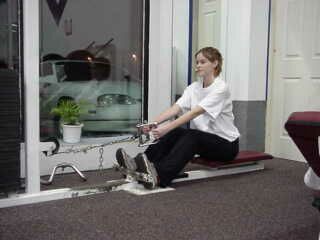
Brace your feet on the footrests, and keeping your arms stretched out in front of you pull back until with a straight back you are leaning slightly backwards.
Weight training for Iaido?! Yes you read the title right, though many may think that both activities have little or nothing in common with each other, nothing could be further from the truth. Weight training for me falls into the same category as jogging and proper nutrition, it is a way to develop and maintain a healthy lifestyle. It is a way to ensure that you and your body are both mentally and physically able to cope with the stresses we have to endure on a daily basis. It is also a way to enhance the skills needed for success within the world of Iaido.
I blame my weight training fascination on my grade seven and eight art teacher, Mr. Miya, by coincidence a gentleman of Japanese ancestry. He would drag the weights out of the storage room after school whenever any of us showed an interest in training. A small man of perhaps 5'4'', he was incredibly strong for his size, I was completely impressed. I had to be strong too! Santa brought me my first weight set that Christmas, and now twenty-five years of trail and error later I have acquired a vast reservoir of knowledge.
People generally begin weight training for a variety of reasons, to get bigger, stronger, to firm up and even to become more attractive to members of the opposite sex. Almost every male in the Western world has lifted weights at one time or another in their lives, but very, very few have made it a habit. If I recall correctly, Arnold once said that weight training is better than sex, if you have ever been serious at weight training you will understand the truth behind such a declaration.
Iaido is so much more then mastering the dance steps involved in the various kata, as is weight training more then simply pushing weights around. There is much more going on below the surface in training for each, if one is willing to look, and more importantly to learn and understand. Unfortunately such insight takes many years of training to realize and many, many more, if ever, to master.
The three sports that rely on weight training for their existence, bodybuilding, power lifting and Olympic weight lifting can provide we, ever so humble, students of Iaido with many useful lessons.
Bodybuilding is essentially a sport of presentation and illusion. Large shoulders with a narrow waist when combined with massive thighs present an illusion of size even if the bodybuilder weighs 170 pounds. Look at pictures of body builders like Lee Labrada and Lee Haney, it is impossible to tell which one is taller or heavier, unless you compare them side by side. It is all about how you present yourself to the audience and more importantly to the judges. On stage you would never, ever draw attention to any weakness you possess. You always maintain a persona of strength and confidence, to do otherwise would be to court defeat. In the pose-down one goes head to head with the other competitors, showing no fear, only a willingness to challenge others who may in fact be better developed then yourself. Years of hard training and brutal dieting come down to these few moments on stage, nothing else now matters except victory.
Now think of an Iaido competition, demonstration or grading. Standing before the judges you must present an aura of confidence, you must present yourself in a manner that demonstrates that you are in complete control over yourself and you are in fact a master of the etiquette and kata you are about to perform. As in bodybuilding you would never draw attention to a flaw on your part, your every movement must have the obvious purpose of demonstrating a hard-acquired skill, and you must have the willingness to challenge your abilities. When choosing which kata to do for grading you pick what you think are your best ones, like a bodybuilder you would never draw attention to your weaker skills.
Successful Power lifting and Olympic weight lifting skills come only after years and years of practice. Quite literally millions of pounds of iron will be moved just in practice alone, saying nothing at all about the amount of practice time involved, the strict nutrition demanded and the technical skills involved. Goals are set and then challenged and destroyed, with new, more ambitious goals taking their place. Imagine having to practice Mae for hours every day for years, with a sword that continuously increases in weight.
Power lifting is, as the name implies, about power. Brute strength in the bench press, the squat and the dead lift is the key to success. This sport however is not about simply being strong, there is a great amount of focus needed for a successful lift. I once saw a man literally slam his head against a bar seconds before a record squat lift. Iím not talking a gentle tap either, this was a shot that I was sure would take him out of the competition. How many of us are willing to slam our heads against a piece of steel prior to an Iaido grading? Afterwards perhaps!
Olympic weight lifting also demands more than brute strength. There is arguably more technical skill demanded in this sport then any of the other weight training sports. I remember training Olympic style and seeing a fourteen-year old girl snatch up a weight that I couldnít do. This was at a time when I could bench-press 435 pounds and do a 275 pound behind-the-neck press for three, at a body weight of 195 pounds. I simply didnít have the balance or technique needed. I developed a new respect for the skill involved in Olympic lifting that day and a new understanding in the importance of technique.
Only continuous practice of Iaido will enable us to reach the goals we set for ourselves. No one who weight trains can be a success by training once or twice a week, in the same way success in Iaido does not come by infrequent training. Success in weight training and Iaido come from learning from our mistakes, place your feet wider apart, bend your knees more, hold your wrist down, stretch, square the hips the list can be endless.
Various advantages from simple weight training will develop in the practitioner of Iaido; increased strength, endurance, flexibility and confidence. These can all be achieved by beginning a simple weight-training regime.
The program I describe here is strictly for beginners. If you are already weight training in any capacity and require a more advanced program we will deal with that in another article. This program is as basic as you can get and is not going to help you win the Mr. Universe title any time soon.
To begin with, as always, please ensure that you have been given the okay to begin weight training by a physician. If you are already a student of Iaido you should be active enough to begin training right away.
Please do not be fooled by the muscle magazines that flaunt the nutrition and training of ultra muscular men and women. Most of these professionals have been training hard for years, they make a living out of their respective sports and live off of the financial rewards these magazines generate for them. The nutrition and weight training advice given is for the most part excellent, if you are in the top ten percent of your sport. For the rest of us it is the path to over training or injury.
To start with we must understand the basic nutrition needed by a weight training athlete. Here there is still a great deal of controversy, for the most part a normal diet will suffice, lean protein sources, fruits and vegetables, grains and dairy products. As we are not training for the Olympia contest the only change to a ďnormalĒ diet I would make at this stage of training would be to add a little extra protein. Ideally you would want to consume this protein within an hour after your workout. The extra protein will help your muscles grow and recuperate after a strenuous workout. Now when Iím talking protein I donít mean stopping off for a double whopper on the way home from the gym, though I donít know of any gym rats that havenít done the deed! You need a lean source of protein, skinless chicken, turkey, tuna or even a quality protein drink. I personally prefer a protein drink simply because itís easy.
Once you become accustomed to training you will realize what all serious bodybuilders understand. The whole thing is 90 % nutrition. Thatís right, exercising is only a tiny part of muscle development, itís mostly what you eat. If and or when you finally become serious about weight training keep these three thoughts in your head: eat big, sleep big and lift big!
Beginners make a terrible habit of over training their bodies, it seems to be a mark of pride to say that youíve trained every day for three weeks. The human body needs time to recuperate from stressful activities, including weight training. At the beginner stage in weight training you should be weight training only every other day. That does not mean though, that you canít jog or practice Iai every day, of course you can!
There are many dozens of muscles within each of us, however for the purpose of training we will divide the human body up into eight muscle groups. We will be discussing the different exercises that will enable the individual to effectively train these groups. The muscle groups are: the back, chest, shoulders, arms, legs, abdominals, forearms, and calves.
Experienced people will notice that there are both compound and isolation exercises listed. A compound exercise is, simply put, an exercise where you have movement in more than one joint. For example a bench press uses the elbow and shoulder joints in order to complete the movement, thus this is a compound movement, whereas in the performance of flyes only the shoulder joint is used and is thus an isolation exercise.
I am going to list some of the more common exercises that are done in a basic gym. As Iíve said we are not training for the Olympia, so
For a beginner:
Weight train three or four times a week Preferably every other
day.
Train two body parts a training session. Chest/triceps, shoulders/biceps, legs/abdominal, back/forearms.
Choose two exercises per large muscle group, ( chest, back, shoulders, legs), and one for the small groups, (triceps, biceps, abdominal, forearm). You should outgrow this routine within six-eight weeks. If that is the case add another exercise to the body group, try other exercises, or increase the weight that you are using. Do not rush it!
Stretch the muscle group to be trained prior to, and throughout your workout.
You should be doing five (5) sets of each exercise. Broken down: first set fifteen repetitions, second set twelve reps, third set eight reps, fourth and fifth set five to eight reps. Each set should be progressively heavier in weight than the one before it. When deciding on a weight to use for your exercises, experiment-using light weights, be safe! You can always increase the weight later. If you find that you can bench press ninety-five pounds five times and no more, then use that as your benchmark. In such a case start off with a weight that will allow you bench press it fifteen times, (based on five at 95lbs, I would sayÖ55lbs) That doesnít mean using a weight that you can easily throw up twenty times. It means that by the time you get to your fifteenth rep, the tank is empty, the same is true for your other sets as well! Remember to use a spotter! Grab a friend, your training partner or any stranger in the gym who looks like they can handle the weight you are using. Ninety five percent of people will gladly give you a spot.
BACK
Strictness of form is always a must in weight training, for two reasons. One, is to maximize the intensity of work on the desired muscle and two, to prevent injury. Improper use of weights when training your back can have a catastrophic effect on your life. Always maintain strict form, no cheating and use a reasonable weight.
Exercises:
Seated rows- My personal favorite for back. Sit down on the platform provided, reach forward and with both hands take hold of the handles.

Brace your feet on the footrests, and keeping your arms stretched out
in front of you pull back until with a straight back you are leaning slightly
backwards.
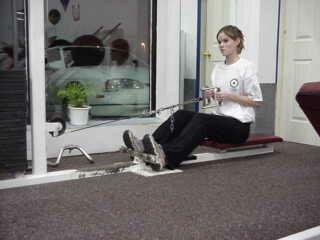
Keeping your back straight pull the weight towards you until your hands come into contact with your chest. Keeping the weight under control allow the weight to straighten out your arms.
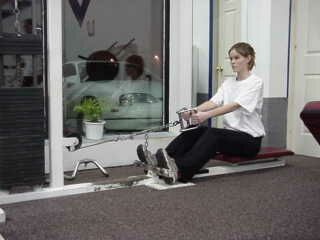
One arm dumbbell rows- Place a dumbbell on the floor beside a standard flat bench. Leaning over the bench place your left knee and left hand on the bench. Bending down using your right knee grasp the weight with your right hand, and straighten your right knee.
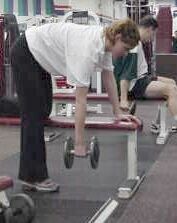
Leaning over this way pull the weight towards your chest.
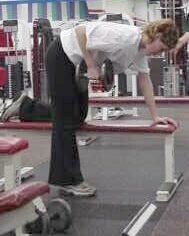
Once it touches your chest and keeping it under control lower the weight.
Repeat.
Shrugs- A lot of people tend to put shrugs in with their shoulder exercises when training, but because there is such a direct emphasis on the trapezius I have always found it best to include it with my back workout. Grasping the barbell with your hands at about shoulder width apart, straighten your body up and lift the bar until it hangs freely in front of you.
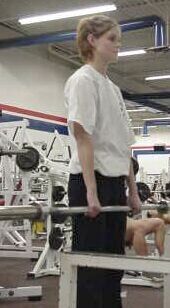
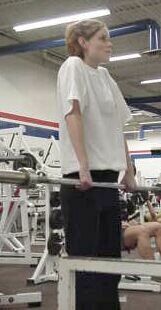
Now without using any shoulder or arm muscles, shrug the bar upwards, trying to make your shoulders touch your ears. Now keeping the weight under control lower the bar to the starting position and repeat.
Stiff leg deadlift- Of all the weight-training exercises you can possibly do in your life, this is the one that can do serious injury to you. If you have had any back injury or suffer from any back problems, donít mess around, do not do this exercise! The one rule with this exercise, keep it embarrassingly light. At my peak I rarely went over 135lbs. I could do much more than this but I was not going to jeopardize my back in order to satisfy my ego. I found that high repetitions were the route to go. Many times 95lbs made my hamstrings and lower back hurt for days. Begin the exercise the same way you began shrugs, hands shoulder width apart on the bar and raise the bar until it hangs freely in front of you.
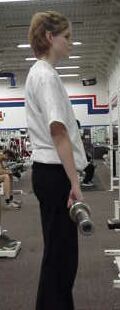
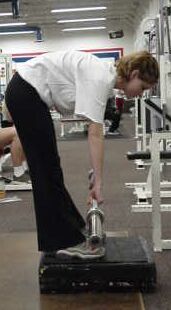
Now keeping your legs stiff, bend at the waist and lower the weight as far down, as it will go. Most people will use a small platform to avoid the weights themselves from limiting your range of motion. Once you have reached bottom, using your lower back muscles straighten up until you return to the standing position. Repeat. Prior to doing this exercise and in between sets stretch your back and hamstrings.
CHEST
We all seem to have this fascination with how much we can bench press. Remember football in high school? The more you could bench press the closer to the centre you got. At 5í6Ē, 150lbs, I could bench the same as our centre who was 6í6Ē, 270lbs, so naturally I became right guard. What a stupid way to determine positioning! I quite literally got crushed. Strictness of form and proper technique is what counts here, not weight.
Exercises:
Bench press- Of course the most basic exercise we all know. Do not become complacent with it. I had a friend drop 245lbs on his face once, naturally it required many hours in plastic surgery to put him back to normal. Donít try to bench press an insane weight before you are ready for it! Placing your hands on the bar, about two hand widths past your shoulders, lift the bar from the rack.
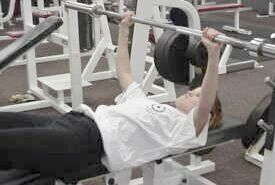
Begin lowering the bar, under control until it touches your chest, now drive the weight upwards until it is at the top again. Repeat.
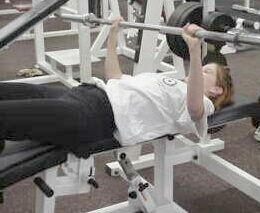
Sounds simple right? Do not arch your back while performing this. Do not bounce the bar off of your chest at the bottom. Watch for the placement of your hands, two fist widths is just an estimate. The further your hands are from centre the more direct emphasis is placed on the chest muscle itself, placing your hands closer to centre will put more of the emphasis on the triceps.
Incline bench press- The same technique and rules are to be applied here as in the bench press.
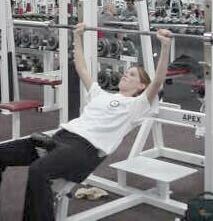
Using an incline bench lift the weight from the rack and lower it to your chest, once it touches drive it upward to the top.
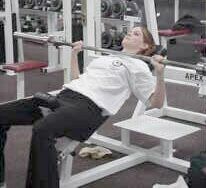
Repeat. One point that I will make here, is that when doing weight training, try to avoid locking your joints between reps. Obviously if the muscle you are working on is almost completely fatigued, by all means play it safe and lock your joint out. By not locking your joints however, you will be forcing the muscle you are exercising to be under constant and continuous stress, thereby working harder.
Flyes- Flyes will give your chest muscles the best stretch they have ever seen. Lay on your back with a pair of dumbbells raised above you. Your elbows should not be locked out; instead they should be slightly bent. Now lower the weight you have chosen down and out, bending only from the shoulders. Keep the angle of your elbows reasonably constant.
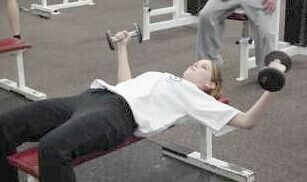
Once you have reached the bottom point in the movement, where you canít lower the weight any further, raise the dumbbells back over your chest. Repeat.
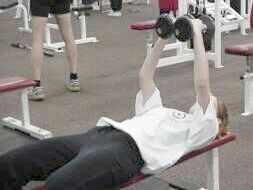
Pec deck- I found when I first started working out that the pec deck was one of my favorite exercises. Today I use it more of a good finishing exercise, something to completely total my chest on at the end of a work out. A Pec deck is very similar to flyes, with the obvious exception that you are seated. Once seated in the pec deck machine, ensure your arms are comfortable on the two armrests. You can have your arms slightly raised or lowered, go by feel, if it feels to low or high it probably is. Adjust your seat accordingly.
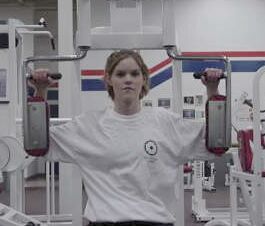
To begin, bending your arms only at the shoulder, drive your arms together using your chest muscles. Drive until the padded armrests click together, or as far as you comfortably can.
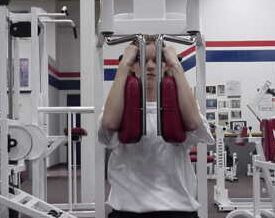
Once out front, under control let your arms return to the back position. Use your chest muscles to resist the weight trying to pull your arms back.
SHOULDERS
My personal all time favorite body part to train! Shoulders are one of those essential joints in our bodies. Think about it, almost every movement our upper bodies do in a gym, and in life, we need our shoulders. All of the exercises that we do to build up our shoulders are movements you would rarely do outside of a gym. How often do you have to push a weight over your head at work? How often do you have to lift a weight from your waist to your shoulder height with one arm? Shoulders are the most unforgiving body part when it comes to sloppy technique. You blow your shoulder out and you can kiss your workouts and Iai training good bye for a few weeks or months.
Exercises:
Military press straight bar- The military press is to shoulders as the bench press is to your chest workout. It is the core, most basic and best exercise going. Iím assuming that most people reading this have some access to basic work out equipment, including benches of some sort. The military press can be done either from the seated position or from the standing position. Weather you are seated or standing, keeping your hands slightly more than shoulder width apart, raise the barbell up to neck height.
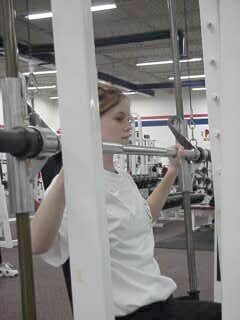
Locking it up there, with your elbows down and slightly forward, push the bar straight up and over your head. Once you have reached the top, lower the bar under control until it is back at your neck height. Repeat.
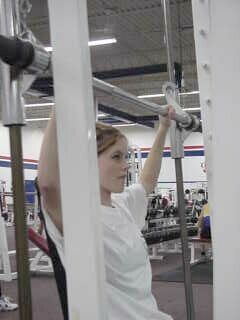
Military press dumbbells- Same idea as above.
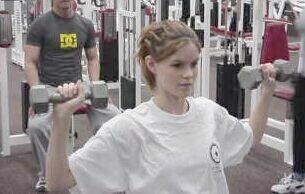
Obviously instead of using a straight bar you use dumbbells. This allows the shoulders to move through different ranges of motion. Nice change to your routine
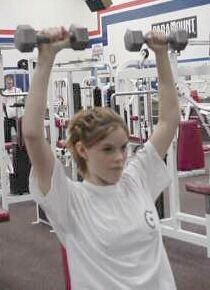
Side Lateral raises- If you want width in the shoulders this is the exercise for you! This can be done one dumbbell at a time or two take your pick. Standing with your feet about shoulder width apart, hold two, (one) dumbbells naturally in front of you.
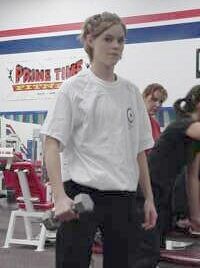
Now keeping your elbows somewhat stiff, use your shoulder muscles and raise the dumbbells out to the sides of your body. Continue raising them until your arms are parallel to the floor.
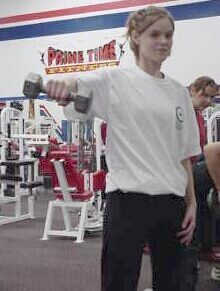
At this point simple reverse the motion, remembering to keep the weight under control. Keeping the elbow stiff allows the needed power to come from the shoulders and not the arms. Repeat.
Bent Over Lateral raises- This movement is needed to complete the shape of the shoulders. As the shoulders are made up of three different heads this movement will isolate the rear delts, whereas the above exercises focused on the front and sides. Keep in mind the arm and shoulder movements that were necessary to perform the side lateral raises. Stand with your feet about shoulder width apart, holding two, (one) dumbbells naturally in front of you. Now bend your back over to about 60-70 degrees.
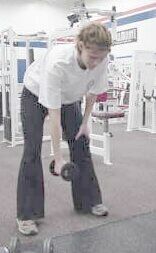
From this position raise the dumbbells out, keeping your elbows stiff, and try to touch the ceiling. Once your arms have reached parallel to the floor, and under control lower the weight back down. Repeat.
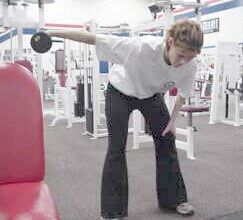
LEGS
All right lets all admit it, there is little to compare to a great pair of legs. Nice well shaped legs that go all the way up to a great rear end. Whew! Heads turn for both men and women. Nice legs, the whole lower body essentially, including thighs, hamstrings, and calves, come through amazing genetics, (until your about 22), and for the rest of us exercise. Iaido quite simply demands strong legs. How else can you put power in your cuts? Square the hips? A stable gun platform is necessary for the upper body to look good.
Exercises:
Squats- If you can only do one exercise for legs, this is the one. It is the greatest weight training exercise for the human body. It helps your cardiovascular fitness, develops the muscles in the entire lower body and strengthens your whole body. It is also one of the most dangerous exercises, when done incorrectly. Technique is critical here. To begin, do this exercise only off of safety racks. Get up under the barbell; position it so it rests across your upper back, where the neck and upper back meet. Grip the bar where it feels comfortable, and where it feels like you have control of the bar. Lift the bar off of the rack. Have your feet placed slightly more than shoulder width apart. Keep your back as straight as possible during this exercise, look upwards as you lower the weight.
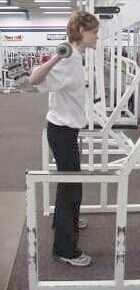
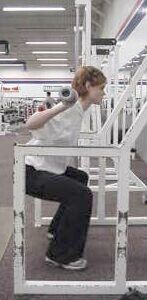
With the bar in the proper position, using your legs not your lower back, lower yourself and the bar, until your thighs are parallel with the floor. Do not go beyond parallel! At this point power upwards until you are back in the standing position. Repeat.
Leg presses- This power exercise provides great isolation of the quadriceps. The angle of the leg press machine should be in the 45-degree range. Adjust it so the angle is both comfortable and is still able to hit the quads. Position yourself in the machine, extend your legs and release the safety locks.
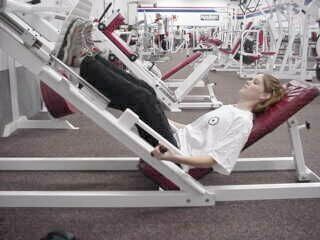
From this position simply lower the weight down until your upper and lower legs are in a 90-degree angle to each other.
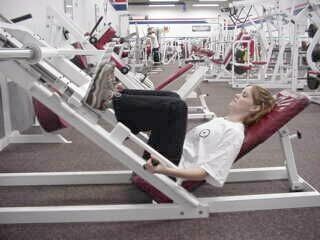
At this point using your quadriceps drive the weight upwards. Repeat. The advantage to weight training with machines and preset racks is that it is very hard to do a lift incorrectly. However do not get complacent with your safety. I have been hurt seriously only once in weight training and this was the machine that allowed me to do it to myself. Think of Iaido and the centre line. Do not move your body out of the centre line on this exercise do not twist your upper or lower body to one side at all, keep your body straight on the line. Trust me, a week off work and prescription painkillers is not pleasant.
Leg extensions- In my opinion, this is a great shaping exercise for the lower quads. Another simple exercise, but again do it correctly. Do not ďbounceĒ through it! After adjusting the machine to fit your body type, sit in the leg extension machine, fitting your shins under the padded bar.
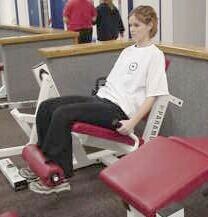
Keeping your body centred and flat on the chair, use your quads to raise the weight upwards. Once your legs are at a 180-degree angle, lower the weight. Repeat.
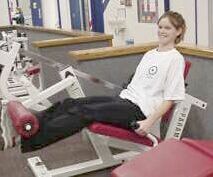
Leg curls- Two exercises that can give you a nicely shaped rear end are the squat and the leg curls. Leg curls are the reverse of the leg extensions. Set the machine up so your body type feels comfortable within it.
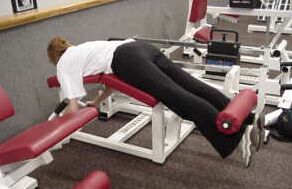
Lying on your front, position your legs under the rear padded bar, now using only your hamstring muscles pull your ankles back towards your rear end. When you reach the point were you could not pull the weight back any further, lower the weight. Repeat.
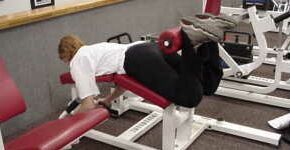
Standing calf raises- The two things that I have always emphasized when training calf are (i) Make sure that you put your calves through the full range of motion, that is as far down as they can go and as far up as they can go. (ii) Donít try to impress people by loading up the calf machine with incredibly huge weights, people donít really care. Use a weight that you can use safely and a weight that allows you to do your sets with correct technique. All too often I see people ďbouncingĒ through their calf workouts, with a large weight and terrible technique. Then they complain that they have calves that just will not grow! Again set the machine for what is comfortable for your body type. Allowing the padded bars to rest on your shoulders, position your feet on the platform. Lift the weight up off of the rack. Now using only your calves, bend your ankles, so the weight is driving your heels into the ground.
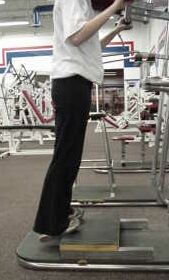
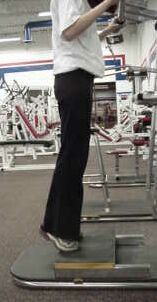
At this point were you can go no further drive upwards using your calves until you are up on the balls of your feet. Repeat.
ARMS
Pipes and guns. They have to be most noticeable part of someone who weight trains. Tank tops and tee shirts make those hours of work on your arms stand right out for all to see and admire. We will discuss training the three muscle groups that make up the arms, the biceps, the triceps and the forearms. The two questions most asked of weight trainers? How much can you bench? And how big are your arms? Unfortunately power in Iai doesnít come from the arms, but from the whole body, specifically the hips. However increased arm strength will give you the endurance needed to practice for greater periods of time.
Exercises:
Standing barbell curl- The simplest and still the best exercise to begin with for a bicep development program. Begin with your feet just past shoulder width apart, let your arms hang naturally at your side. Bring your arms straightforward and grasp the bar. Your hands should be evenly spaced on the bar about shoulder width apart. Lifting the bar off the rack let it hang naturally in front of you,
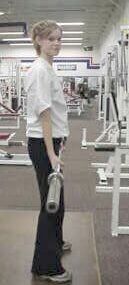
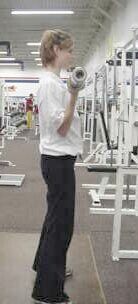
now curl the bar upwards, until you can go no higher. When doing this exercise do not arch your back to help the weight forward and keep your elbows ďlockedĒ into your side. Lower the weight and repeat.
Preacher curls- This is a very strict exercise with little room to cheat. Thus a very effect way to build the biceps. Once you have set the bench up to a comfortable position for your body, grasp the bar you have set up, keeping your hands again about shoulder width apart.
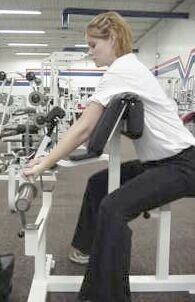
Lift the bar upwards until again it will travel no further up. Keep your elbows on the bench. Lower under control and repeat.
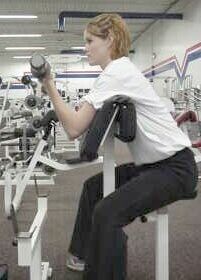
Cable press downs- Time for the triceps. If you want big arms, you simply must have big triceps. The triceps make up 2/3 of the upper arm mass, with biceps obviously making up the other 1/3. So without nice triceps you can never have nice pipes. Cable press downs are an easy and effective way to hit the triceps. Set the machine up so it is comfortable for you. Gasp the bar so that your hands are again about shoulder length part. Lock your elbows into your side or just make sure that your upper arms do not pull forward or back during the exercise.
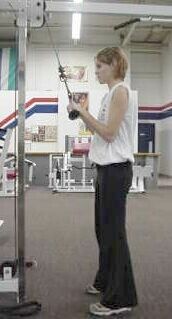
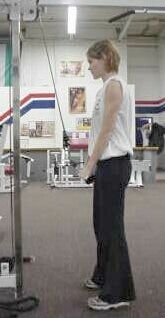
Push the weight down in front of you until you can push down no further. Under control allow the weight to come back up. Repeat.
Tricep extensions- Set up a small EZ bar or a small straight bar with your desired weight. Lay flat on a bench and have someone hand you the bar. Hold the bar straight up and over your head.
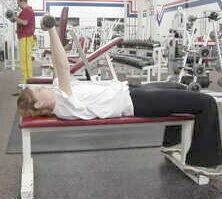
Now again keeping your upper arms relatively straight lower the bar to just behind your head. When your arms have reached about 90-degrees drive the weight back up and over your head. Repeat.
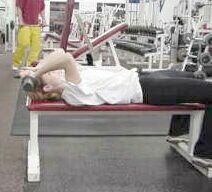
Barbell wrist rolls- Pick up a bar and hold it about shoulder width apart in front of you, sit down on a bench and place your forearms on your thighs, with hands facing up. Let the bar rest in your palms. Allow the bar to roll downwards towards your fingers.
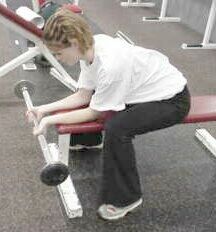
Now using only your forearm muscles pull the weight upwards. Lower and repeat.

ABDOMINALS
The six pack. Let me tell you something you can do thousands of sit ups everyday in the gym, and have absolutely rock hard abs. However if you are carrying too much body fat, no one will know about it. Forget all those gimmicks on TV that show very lean and well-developed people using these amazing technologically advanced machines that can give you to abs of steel, for only three easy payments of $99. Please just forget it. If you're 5í7Ē, 220 lbs., and donít exercise, this type of machine is only making the distributor money. For iaido, so Iíve been told, apparently itís a good thing to have a bit of a gut, as it helps you settle into your cuts. Personally Iíll go down fighting.
Hanging leg raises- Iíve added this one and only exercise because I feel that itís the best one for your abs. Truthfully if you're just beginning to weight train do anything for abs. Sit-ups are fine, we're not training for a bodybuilding competition! Any exercise you do will be more than what youíve been doing, and in six weeks you'll change. This exercise, like all the others Iíve listed, needs to be done in strict form to get the maximum benefit. Hang from an overhead bar, and bend your knees slightly.
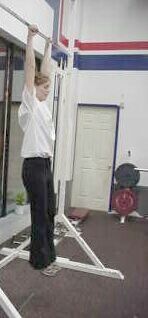
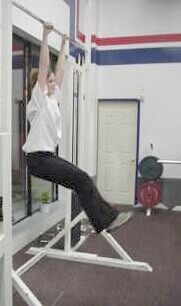
Using you stomach muscles raise your feet upward in an arc, aiming for your head. Once your feet have reached your belly button, stop and under control lower your feet. Repeat.
Thatís all there is for now folks. Itís just a very basic weight-training
program. Donít get upset with yourself if you miss a workout, you eat too
much or a variety of other socially implied guilt trips. Just start over.
Remember the majority of people donít do any exercise at all, so what ever
you do will put you miles ahead of the pack.